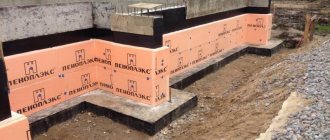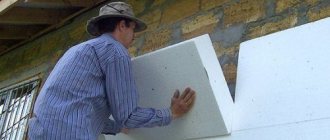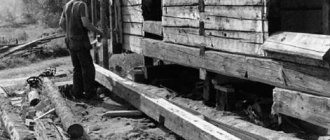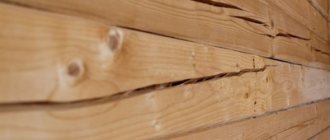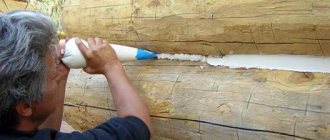Penoplex is a type of foam plastic used in insulation. To know how to attach penoplex to a brick wall, you need to have an idea of the features of this thermal insulation material. Brick is a good and convenient material for building structures, but its main disadvantage is the low level of thermal insulation, especially in the cold season. Penoplex is often used to insulate various buildings; its main advantage is a high level of protection from external environmental influences.
Penoplex is great for home insulation.
Specifics of fastening to different types of walls
Penoplex is an effective insulation material that is popular due to its performance qualities and ease of installation.
One of the key factors influencing the choice of fastening method is the type of surface. The slabs are fixed to different bases using various compounds and additional devices. The correct choice of installation method is the key to the durability and efficiency of the heat-insulating material.
Concrete
Concrete surfaces are porous, which affects the degree of absorption of mixtures. Before attaching penoplex to concrete, the base should be treated with a primer. This will reduce glue consumption and improve the adhesion of materials. To attach penoplex to a concrete wall, you will need not only a layer of glue, but also additional dowels. This increases the reliability of insulation fixation. To prevent moisture absorption by the concrete wall, you will need to lay the slabs in a checkerboard pattern.
Brick
There are many options for installing penoplex to a brick base. Professionals recommend not stopping at this method, but combining different methods. The difficulty in fixing the insulation is the unevenness that has a base. To minimize the negative consequences of this phenomenon, before attaching penoplex to a brick wall, it is worth priming it. The following methods are used to fix sheets:
- glue;
- foam;
- liquid Nails;
- cement mixture;
- dowels;
- self-tapping screws
When using dowels as additional fastening, you will need to pre-drill holes in the brick wall with a hammer drill.
Block
Professionals highlight several rules for attaching penoplex to a wall made of aerated concrete blocks. This is due to the special structure of the material, since block walls are more susceptible to the negative effects of moisture than other types of foundations.
To do the installation correctly, you should adhere to the following recommendations:
- Glue consumption is increased when attaching to aerated concrete blocks. To reduce costs, the surface is pre-treated with impregnation.
- To improve adhesion, uneven surfaces on the wall are removed using a rail with a special attachment.
- Fasten the sheets offset, avoiding the coincidence of the joints of the plates with the technological seams.
- When choosing what to attach penoplex with, give preference to non-aggressive adhesives.
When installing insulation on aerated concrete blocks, you can use lathing or use the standard method of fixing it with glue. The first option in this case is more reliable and effective.
Wooden
Thermal insulation of wooden buildings with extruded polystyrene foam has a significant disadvantage - almost zero vapor permeability, which eliminates the ability of the walls to “breathe”. This leads to changes in wood dimensions and subsequent shrinkage of the structure. In order for insulation to have fewer negative consequences, you will need to carefully prepare the base. The wall is first leveled with a plane, then the cracks should be repaired, the surface should be impregnated with an antiseptic and fire retardant. The best option for thermal insulation is to attach penoplex to the frame. If the master attaches the sheets directly to the walls, then two-component glue and self-tapping screws are used as additional fasteners.
How to properly insulate a wooden house?
When insulating stone walls, you can choose any of the above methods and implement it. But you should be especially careful with wooden buildings. The fact is that wood, a breathable material, cannot simply be taken and wrapped in film. As a result, it will simply rot in a few years. Wooden walls urgently need to constantly receive fresh air.
What to do? For such surfaces, creating a ventilated façade is suitable. What does it mean? There must be a ventilation fence between the wall and the insulation. That is, first the sheathing is attached to the walls using bars, and the insulation is already fixed on them. Do not forget to treat all wooden components with an antiseptic that fights mold and fungi.
The availability of the above methods of attaching Penoplex allows everyone to independently choose the most acceptable option. At the same time, the relative simplicity makes it possible, if desired, not to resort to the services of specialists.
You can purchase Penoplex and other types of extruded polystyrene foam for various purposes. Visit our catalog and choose the appropriate option. And in case of difficulty, we are always ready to help!
Mounting methods
Having studied the features of the base and selected the appropriate installation option, you should decide on the materials. They must be suitable for the insulation and the surface to be insulated to ensure maximum adhesion. To increase the reliability of fixation, several installation methods are used simultaneously.
With lathing
Building a frame takes more time. It is important to decide on the lathing material.
Wood slats or aluminum profiles can be used. After constructing the frame, foam boards are inserted into it. They are sealed with polyurethane foam. The final finishing is carried out on top of the thermal insulation material, for which siding, block house, etc. are suitable.
Polymer and bitumen mastics
Mastics are universal, therefore they are used for installing extruded polystyrene foam on walls, plinths, foundations and other structural elements. These viscous mixtures are sold in ready-to-use form. The content of petroleum products requires compliance with safety precautions during application. For reliable fixation, it is necessary to evenly apply the mixture onto the foam sheet and press it tightly to the base for 60 seconds.
Dry mixes
With the help of dry building mixtures, you can save money, since they are among the most affordable on the market. It is important not only to know how to properly attach penoplex, but also to observe dilution proportions to ensure high-quality fixation. For ease of mixing, a special construction mixer is used. The mixtures are made on a cement base and are ideal when working with concrete bases.
Disc-shaped dowels
Dowels for thermal insulation have a wide head. They are often used for insulating brick buildings. For fixation, holes are first made in the wall, up to 6 cm deep. They are filled with foam, after which the fasteners are inserted. Each foam board will require at least 5 dowels. They are attached at the joints of adjacent slabs, as well as additionally in the middle of the sheets.
Main stages of installation
Regardless of the method of attaching Penoplex, this process includes the following work:
- A horizontal guide is marked along the entire perimeter of the house using a chokeline or level.
- The required level is set, the beacons are fixed using a thread.
- The bar is attached to the dowels along the guide.
- The best way to fix Penoplex is to stagger the sheets from bottom to top. The resulting voids are filled with polyurethane foam
- Upon completion of fastening, it is necessary to perform decorative finishing of the building.
Types of dowels
Disc-shaped dowels differ in size and diameter of the cap. The main classification affects the material of manufacture. According to this criterion, they distinguish:
- Polymers are characterized by low strength. Therefore, the cost is low. This option is suitable for concrete and brick. Such dowels are unable to withstand increased loads.
- Metal dowels are more durable, but have high thermal conductivity, which negatively affects the result of insulation. This leads to the formation of cold bridges. The susceptibility of metal to corrosion causes yellow spots to appear. To avoid this phenomenon, you will need to treat the rods with an anti-corrosion compound.
- Metal ones with a thermal head are designed as an alternative to metal dowels. Coating the cap with metal with a low thermal conductivity coefficient eliminates the appearance of cold bridges. This feature affected the price of the products. The cost of metal dowels with a thermal head is high.
Disc-shaped dowels are selected taking into account the characteristics of the insulated surface, which will allow you to get the maximum benefit from thermal insulation and extend the service life of the insulation.
Liquid Nails
When insulating surfaces of a small area, it is advisable to use liquid nails. You will need a glue gun for application. The composition is applied to the foam board around the perimeter, as well as in the center. Fixation is almost instantaneous, just press the sheet firmly to the surface. To use this type of fixation, you will need to perfectly level the walls and also prime them. When thermally insulating surfaces of a large area, using liquid nails is irrational from a financial point of view, since the cost of the material is high.
Self-tapping screws
The easiest way to attach penoplex is with self-tapping screws. This installation method is only suitable when working with wooden bases or when insulating with lathing.
The use of self-tapping screws leads to the appearance of cold bridges and deterioration of thermal insulation performance, since the fastener heads are small and it is necessary to use about 8 pieces to fasten each plate.
Polyurethane foam
Polyurethane foam is used as an additional fastening for thermal insulation using dowels or self-tapping screws. They help seal the joints of the insulation and improve adhesion to the base. The foam is applied to the slab in the same way as liquid nails: along the perimeter and in the center.
Features of insulation
Penoplex is a type of polystyrene foam that is used in construction to insulate rooms outside and inside. The material is suitable for insulating walls, floors, foundations, and roofs. Available in the form of slabs of different sizes, the material is durable, dense and has a number of properties that give this particular material an advantage when choosing insulation:
- high level of thermal insulation;
- low level of water permeability;
- high strength;
- combustion resistance;
- environmental Safety;
- service life more than 50 years.
Easy to install thanks to the tiled release form. The slab covers more than half a meter of surface at once. Well adjusted to fit any angle or unevenness, can be trimmed. Penoplex is a bulky material; the slabs conceal the area of the building and can allow fungus to pass through when exposed to moisture for a long time. But the main advantage remains resistance to temperature changes and ease of installation.
Which side should the penoplex be attached when installing from the inside and outside?
Using extruded polystyrene foam for external and internal insulation, users wonder which side to attach the insulation to correctly. Both sides of the slabs are the same, so there is no difference. The presence of a pattern does not change the situation, since after thermal insulation the finishing is carried out. There are nuances when using smooth sheets. To improve the adhesion characteristics, the surface of the penoplex is pre-treated with a rough roller. In this case, the glue will better adhere the slabs to the surface. If additional fastening with dowels is used, this procedure is not necessary.
Where is vapor non-conductivity needed?
If installed correctly (without gaps and cracks) with joints taped, EPPS does not require the use of vapor barrier membranes. It hardly lets through steam. Neither in liquid nor in gaseous state.
So the use of membranes and waterproofing is unnecessary. When using floors in a cake, this is excellent, because moisture usually comes from the ground. When using polystyrene foam, it does not penetrate either by capillary action or in the form of steam. In this case, this is definitely a plus.
These properties are also a plus when using extruded polystyrene foam in blind areas, under paths, etc. In addition to protecting against freezing, it does not get wet. This allows, with a competent approach, to get rid of frost heaving and make, for example, not a deep strip foundation, but a shallow strip or Swedish slab.
Evgeniy Filimonov
Ask a Question
The use of EPS in the roofing pie of a flat roof is also optimal - leaks are minimized, and almost no heat is lost.
When using on pitched roofs, it’s already worth thinking about. The fact that Penoplex Roofing does not allow moisture into the attic space is good. But it will be possible to remove excess moisture from the attic only with the help of very good ventilation, which includes not only dormer windows. Additional elements will be needed on the ridge, in the roof plane. In general, given the cost of Penoplex, this is not always reasonable.
Double insulation: when used and implemented
Double thermal insulation involves laying insulation in two layers. Most often, penoplex is combined with penofol. The procedure is expensive, so it is recommended to carry it out in exceptional cases:
- for thermal insulation of balconies to expand living space;
- when insulating load-bearing walls and parapets.
The insulation is installed offset to cover the joints and increase the efficiency of thermal insulation. The first layer is fixed using one of the methods described above. The second layer of foam foam can be secured with staples or adhesive.
Using penoplex for insulation can reduce heat loss by more than 60%.
To improve the thermal insulation characteristics, it is necessary to choose the right installation method. This will make the insulation durable and of high quality. When deciding on the installation option, it is necessary to take into account the type of base, the area of the insulated surface and make a choice based on the available financial capabilities.
Design differences
Some of the types of Penoplex have structural differences:
- Penoplex Wall slabs have a rough surface; stripes are applied to the surface of the slab using a router. All this improves adhesion to the wall and/or finishing materials.
- Penoplex Comfort is distinguished by an L-shaped edge, which during installation guarantees the absence of through seams.
- Penoplex Roofing has a U-shaped edge, which increases the reliability of the connection.
This is what concerns external differences. Next, let's look at the technical specifications. First, let's pay attention to what is common to all types, then to what distinguishes them.
Is it profitable to use?
Standards recommend that private owners create economically feasible insulation so that it pays off at current energy prices over a certain period of time - up to 12 years. Therefore, in the design documentation for private houses and apartments, heat insulators are laid out that are quite reliable (durable), but at a reasonable price - insulation should be beneficial for the owner.
You won’t find too expensive foam glass in projects. But cheap high-density polystyrene foam (foam) is widely used.
In house designs, extruded polystyrene foam is used strictly for its intended purpose.
No one will use extruded polystyrene foam where polystyrene foam, which is much cheaper, can be used. Otherwise, the meaning of insulation is lost - it simply will not pay for itself in normal terms, and violation of the standard threatens with deprivation of the design license, for example.
Costs for building materials
Today, the construction markets of Moscow and the Moscow region can offer buyers the following materials at prices:
Penoplex in packs, thickness 100 mm for outdoor use, RUB 1,550;- Penoplex in packs, thickness 50 mm for interior work, RUB 1,250;
- primer solution 10 l, 300 rub.;
- plaster mixtures, 25 kg, 360 rubles;
- fiberglass mesh for reinforcement, 35.50 rub/m2;
- profile fasteners, packaging, RUB 740;
- glue for fixing plates, 25 kg, 230 rub.;
- mushroom dowels for Penoplex, 3 rub. /PC.;
- dowels for fastening supporting parts, packaging, 740 rub.;
- starting profile, 120 rub.;
- facade paint for finishing, 15 kg, 513 rub.
Cost of work in the Russian Federation
The technological process of installing Penoplex on brick walls also consists of many separate operations that determine the total cost of work per 1 m2 of brick wall area.
Prices for finishing work depend on the region where the property is located, transport links and the height of the building.
Average prices by region of the Russian Federation for different types of work:
- Insulation of external brick walls, RUB 380. /m2.
- Internal protection of brick walls, RUB 310. /m2.
- Reinforcement of a brick wall with fiberglass mesh, 410 RUR/m2.
- Rubbing walls with glue, 220 rub. /p.m.
- Primer of walls, 80 RUR/m2.
- Application of decorating plaster, 380 RUR/m2.
- Wall painting, 110 RUR/m2.
If you are interested in how and with what you can insulate brick walls from the inside and outside, take a look at this section.
Tips for use
- Read the instructions on the packaging, take into account the consumption of the product when calculating the required material.
- Buy adhesive with reserve, especially when you need to insulate deformed surfaces with cracks, chips, and potholes.
- It is better for beginners not to use quick-drying compounds, since they will not be able to correct the position of the insulation boards if they are installed incorrectly. Glue in balloons is suitable.
- Before insulation, it is better to treat the surface with a primer; this will prevent the appearance of mold and increase the adhesive properties of the base.
- The glue must be applied evenly over the entire surface, with a layer thickness of no more than 3 mm.
- Insulation boards must be leveled immediately after application to the base.
During all thermal insulation work, safety precautions must be observed.
Surface preparation
Regardless of the chosen method of installing the material, the first stage of work is surface preparation. It should be smooth and clean.
Preparation operations:
Remove all dirt, old finishes, and peeling areas.
If there is mold on the surface, the area is treated with a wire brush and washed with an antiseptic composition. Then dry thoroughly.
After this, alignment is performed. Plastering is used for concrete. The solution is selected individually for the surface material. The insulation can be attached when the plaster has dried.
Metal parts that are planned to be covered with slabs are treated with anti-corrosion compounds.
